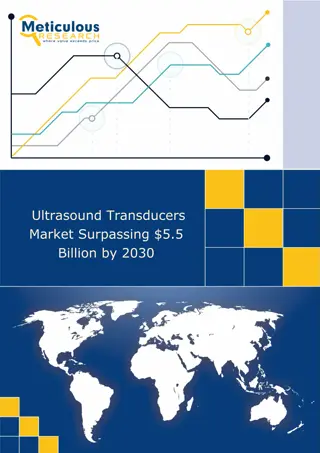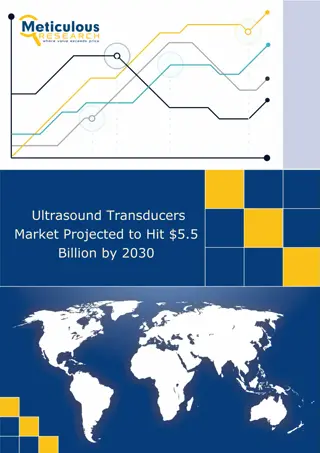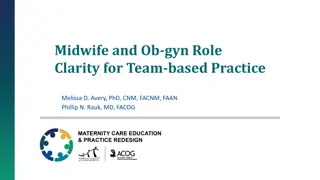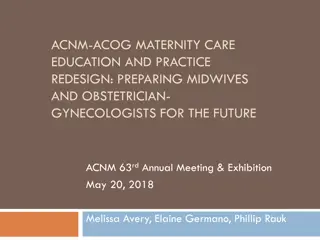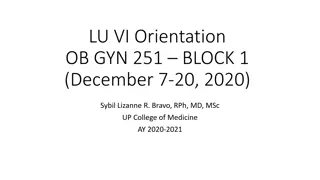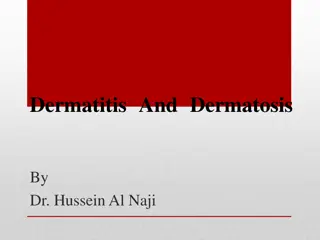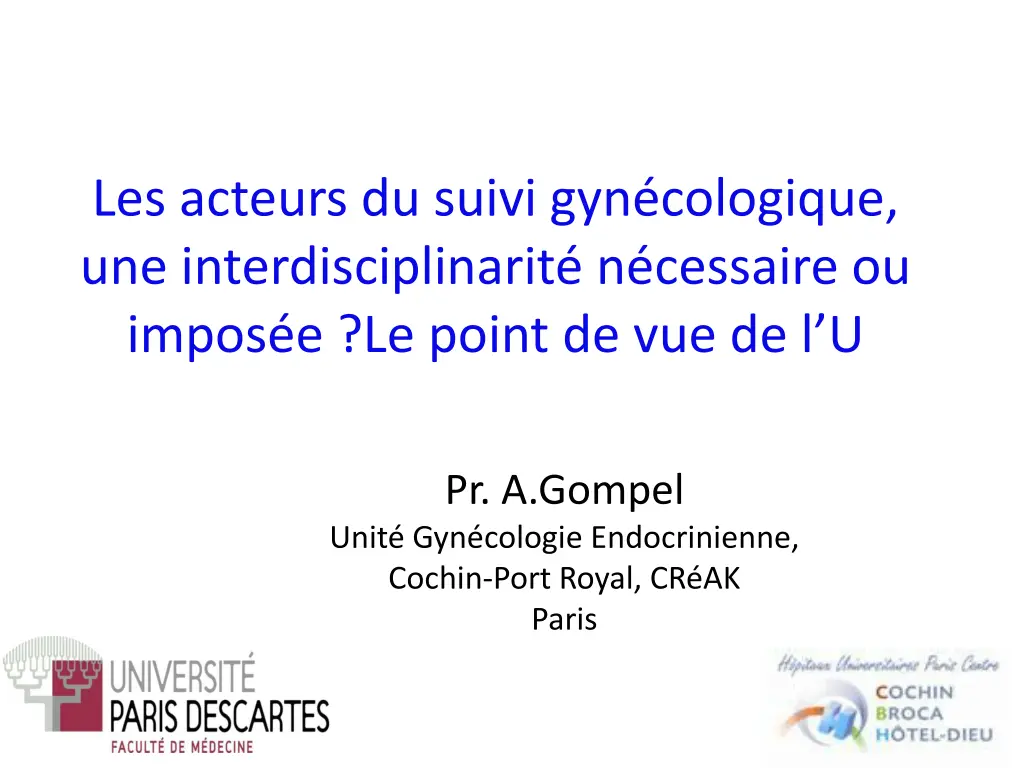
Interdisciplinary Approach in Gynecological Care: Insights from U.Pr. A. Gompel Unit
Explore the necessity of interdisciplinary collaboration in gynecological care through the perspective of U.Pr. A. Gompel Unit Gynecologie Endocrinienne. Discover the evolving landscape of gynecological education, the role of various professionals, and the challenges faced in screening participation and contraceptive decision-making in France.
Download Presentation

Please find below an Image/Link to download the presentation.
The content on the website is provided AS IS for your information and personal use only. It may not be sold, licensed, or shared on other websites without obtaining consent from the author. If you encounter any issues during the download, it is possible that the publisher has removed the file from their server.
You are allowed to download the files provided on this website for personal or commercial use, subject to the condition that they are used lawfully. All files are the property of their respective owners.
The content on the website is provided AS IS for your information and personal use only. It may not be sold, licensed, or shared on other websites without obtaining consent from the author.
E N D
Presentation Transcript
Les acteurs du suivi gyncologique, une interdisciplinarit n cessaire ou impos e ?Le point de vue de l U Pr. A.Gompel Unit Gyn cologie Endocrinienne, Cochin-Port Royal, CR AK Paris
Pass Formation 3ans CES 120/130/an tr s Gyn cologique, variable selon r gions + internes 4ans formation plus interdisciplinaire Qualification : comp tence specialit R sultats: d pistage cancer du col effectif sans DO Mammographie idem 9% hyst rectomies Couverture contraception ++
Prsent DES 4 ans , 48 DES /an /France Formation Gorganique, hormonologie, oncologie gyencologique et mammaire, AMP Post internat >80% des cas, masters 15-16% DESC reproduction 40%, oncologie 10%, m decine l gale, infectieux Une dizaine de th ses de sciences en cours
Avenir Reforme CNIPI 4 ans DES 1 ann e socle, 2 ans consolidation 1 an mise en responsabilit Chaque r forme diminue la formation mutidisciplinaire . Devenir CCA (retaurer fonction HU) et assistants??? Nombre? Role des g n ralistes et sages femmes? Fili res de soins, d l gation de taches Formation, Actes, Encadrement, organisation des maisons m dicales ?? Sages femmes n insuffisant pour suivi grossesse
ORs for screening participation if consulting a gynecologist: 1,7(1,3-2,1) A GP: 06(0,4-1)
DIU Contraception.2014 Jan;89(1):9-16. doi: 10.1016/j.contraception.2013.10.003. Epub 2013 Oct 21. IUD use in France: women's and physician's perspectives. Moreau C1, Bohet A, Hassoun D, Ringa V, Bajos N; FECOND group. Abstract OBJECTIVE: While the intra-uterine device (IUD) is the second most popular contraceptive method in France, its use remains low among women most at risk of unintended pregnancies. Acknowledging the conjoint role of women and physicians in contraceptive decision making, we investigate the determinants of IUD use and IUD recommendations from the user and prescriber perspectives. STUDY DESIGN: Data are drawn from 2 national probability surveys (population-based and physician surveys) on sexual and reproductive health in France. The population based survey comprised 3,563 women ages 15-49 at risk of an unintended pregnancy in 2010 and the physician survey included 364 general practitioners (GPs) and 401 gynecologists practicing in private offices in 2010-2011. Analyses were performed using logistic regression models. RESULTS: Altogether, 21.4% of women were IUD users, with substantial differences by age and parity. Less than 1% of young women (<25 years) and 3% of nulliparous were current IUD users in 2010. The odds of IUD use were four times higher in women followed by a gynecologist as compared to a GP. Mirroring these results, gynecologists were more likely to recommend IUDs than GPs. Misconception about IUD risks was widespread among women and providers. Medical training and information, professional practice settings, and ever use of IUDs also informed physician's likelihood of recommending IUDs, regardless of specialty. CONCLUSIONS: The study reveals the intersection of individual and professional influences on contraceptive use patterns. The considerable age discrepancy in IUD use in France, with very few young women most at risk of an unintended pregnancy using the method, reflects a knowledge gap shared by users and providers. These findings suggest there are significant opportunities to improve contraceptive care in France. IMPLICATIONS: This study stresses the need to inform women and doctors about the benefits and risks of IUDs for all women. Substantial efforts are required to improve the medical curriculum, in order to promote evidenced based family planning counseling and provide GPs with the technical skills to insert IUDs.
En conclusion? Principe: mieux former les acteurs de la sant des femmes C est notre r le Mais: moyens limit s Qui se charge d valuer la comp tence des uns et des autres? Les g n ralistes enseignent aux g n ralistes, les GO,SF aux SF, DUs Exp rience clinique?? En Su de : 40 ans d exp rience et valuation tr s stricte et r guli re



